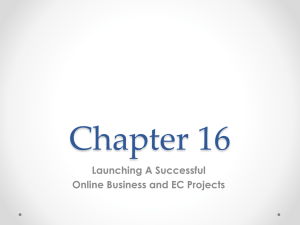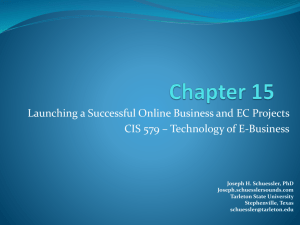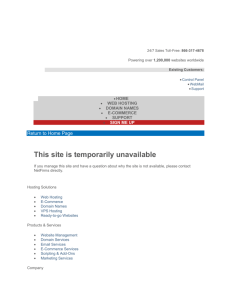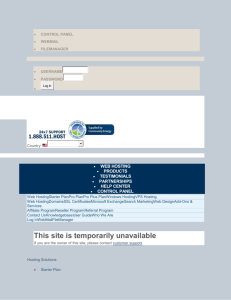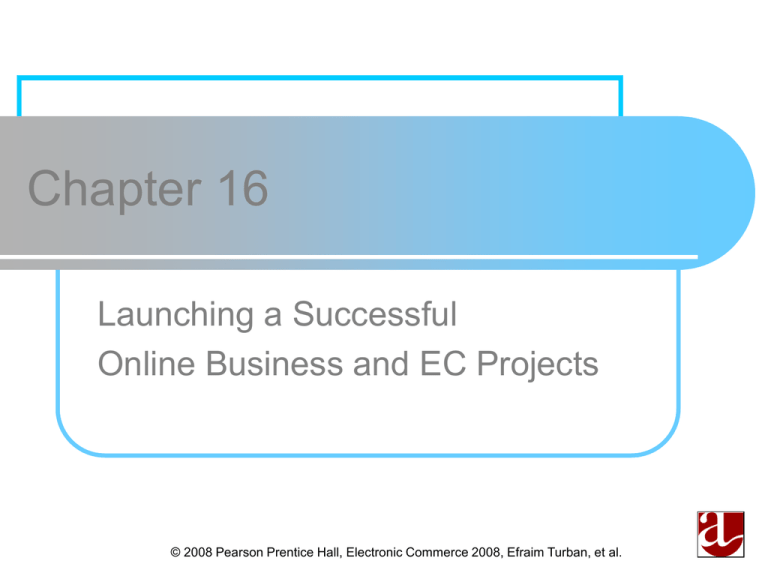
Chapter 16
Launching a Successful
Online Business and EC Projects
© 2008 Pearson Prentice Hall, Electronic Commerce 2008, Efraim Turban, et al.
Learning Objectives
1. Understand the fundamental requirements for
initiating an online business.
2. Describe the process of initiating and funding a startup e-business or large e-project.
3. Understand the process of adding EC initiatives to an
existing business.
4. Describe the issues and methods of transforming an
organization into an e-business.
5. Describe the process of acquiring Web sites and
evaluating building versus hosting options.
16-2
Learning Objectives
6. Understand the importance of providing and
managing content and describe how to
accomplish this.
7. Evaluate Web sites on design criteria, such
as appearance, navigation, consistency, and
performance.
8. Understand how search engine optimization
may help a Web site obtain high placement
in search engines.
16-3
Learning Objectives
9. Understand how to provide some major
support e-services.
10. Understand the process of building an
online storefront.
11. Be able to build an online storefront
with templates.
16-4
Starting a New Online Business
An E-Start-Up Is a Start-Up
An e-start-up is basically a start-up and, as
such, must consider all the issues faced
by a physical start up
Guidelines to avoid dot-com failures:
1.
2.
3.
4.
The growth rate of the market you plan to enter
The timing of your market entry
The revenue flow
What cycle a market is in
16-5
Starting a New Online Business
Steps in Creating a New Company or
Adding an Online Project
1. Identify a consumer or business need in
the marketplace
2. Investigate the opportunity
3. Determine the business owner’s ability to
meet the need
16-6
Starting a New Online Business
Five “secrets” to help you come up with
the next big thing:
1.
2.
3.
4.
5.
Do your homework
Aim for excitement
Whittle, shape, iterate, repeat
Get real
Avoid creating a gizmo
16-7
Starting a New Online Business
Online Business Planning
business plan
A written document that identifies a
company’s goals and outlines how the
company intends to achieve the goals and
at what cost
business case
A document that justifies the investment of
internal, organizational resources in a
specific application or project
16-8
Starting a New Online Business
Funding a New Online Business
First round of initial funding
angel investor
A wealthy individual who contributes personal
funds and possibly expertise at the earliest stage
of business development
incubator
A company, university, or nonprofit organization
that supports businesses in their initial stages of
development
16-9
Starting a New Online Business
Second round financing
venture capital (VC)
Money invested in a business by an individual, a
group of individuals (venture capitalists), or a
funding company in exchange for equity in the
business
Additional funding: A large partner
The initial public offering (IPO)
16-10
Adding E-Commerce Initiatives or
Transforming to an E-Business
Adding EC Initiatives to an Existing
Business
The most common additions are:
A storefront
A portal
E-procurement
Auctions and reverse auctions
Other initiatives
16-11
Adding E-Commerce Initiatives or
Transforming to an E-Business
Transformation to an E-Business
What is organizational transformation?
How an organization can be transformed
into an e-business
Business process reengineering
Business process management (BPM)
Software tools for facilitating transformation
to e-business
Change management
16-12
Adding E-Commerce Initiatives or
Transforming to an E-Business
business process management (BPM)
Method for business restructuring that
combines workflow systems and redesign
methods; covers three process categories—
people-to-people, systems-to-systems, and
systems-to-people interactions
16-13
Building or Acquiring a Web Site
Classification of Web Sites
informational Web site
A Web site that does little more than provide
information about the business and its
products and services
interactive Web site
A Web site that provides opportunities for
the customers and the business to
communicate and share information
16-14
Building or Acquiring a Web Site
attractors
Web site features that attract and interact
with visitors in the target stakeholder group
transactional Web site
A Web site that sells products and services
collaborative Web site
A site that allows business partners to
collaborate
16-15
Building or Acquiring a Web Site
Steps in Building a Web Site
Select a Web host
Register a domain name
Create and manage content
Design the Web site
Construct the Web site and test
Market and promote the Web site
16-16
Web Site Hosting
and Obtaining a Domain Name
Web Hosting Options
storebuilder service
A hosting service that provides disk space
and services to help small and
microbusinesses build a Web site quickly
and cheaply
16-17
Web Site Hosting
and Obtaining a Domain Name
A pure hosting service
Web hosting service
A dedicated Web site hosting company that offers a wide
range of hosting services and functionality to businesses
of all sizes
mirror site
An exact duplicate of an original Web site that is physically
located on a Web server on another continent or in
another country
co-location
A Web server owned and maintained by the business is
given to a Web hosting service that manages the server’s
connection to the Internet
16-18
Web Site Hosting
and Obtaining a Domain Name
ISP hosting service
A hosting service that provides an
independent, stand-alone Web site for small
and medium-sized businesses
self-hosting
When a business acquires the hardware,
software, staff, and dedicated
telecommunications services necessary to
set up and manage its own Web site
16-19
Web Site Hosting
and Obtaining a Domain Name
Registering a Domain Name
domain name
A name-based address that identifies an
Internet-connected server. Usually, it refers
to the portion of the address to the left of
.com and .org, etc.
domain name registrar
A business that assists prospective Web site
owners with finding and registering the
domain name of their choice
16-20
Content Creation,
Delivery, and Management
content
The text, images, sound, and video that
make up a Web page
Categories and Types of Content
dynamic Web content
Content that must be kept up-to-date
commodity content
Information that is widely available and
generally free to access on the Web
16-21
Content Creation,
Delivery, and Management
16-22
Content Creation,
Delivery, and Management
Primary and secondary content
Primary content is information about the
product itself
Secondary content offers marketing
opportunities
16-23
Content Creation,
Delivery, and Management
Secondary content
cross-selling
Offering similar or complementary products and
services to increase sales
up-selling
Offering an upgraded version of the product in
order to boost sales and profit
Promotion
Comment
16-24
Content Creation,
Delivery, and Management
Creation or Acquisition
Buying content
Buying from a syndicator
syndication
The sale of the same good (e.g., digital content)
to many customers, who then integrate it with
other offerings and resell it or give it away free
Web syndication
A form of syndication in which a section of a
Web site is made available for other sites to use
16-25
Content Creation,
Delivery, and Management
RSS
An XML format for syndicating and sharing Web
content
podcast
A media file distributed over the Internet using
syndication feeds. A collection of audio files in
MP3 format
Representative content-related vendors
Content delivery networks
16-26
Content Creation,
Delivery, and Management
personalized content
Web content that matches the needs and
expectations of the individual visitor
Delivering content by e-newsletter
e-newsletter
A collection of short, informative articles sent at
regular intervals by e-mail to individuals who
have an interest in the newsletter’s topic
Writing effective content
16-27
Content Creation,
Delivery, and Management
Content Management and
Maintenance
content management
The process of adding, revising, and
removing content from a Web site to keep
content fresh, accurate, compelling, and
credible
16-28
Content Creation,
Delivery, and Management
Content testing and updating
Measuring content quality
Pitfalls of content management
Content removal
Content management software
16-29
Content Creation,
Delivery, and Management
Catalog Content and Its Management
For B2B buyers who aggregate suppliers’ catalogs
on their own Web sites, content management
begins with engaging suppliers and then collecting,
standardizing, classifying, hosting, and continually
updating their catalog data
Content Maximization and Streaming
Services
Many companies provide media-rich content, such
as video clips, music, or Flash media, in an effort to
reach their target audience with an appealing
marketing message
16-30
Web Site Design
information architecture
How the site and its Web pages are
organized, labeled, and navigated to
support browsing and searching
throughout the Web site
16-31
Web Site Design
Web Site Design Criteria Navigation
Consistency
Response time
Appearance
Quality Assurance
Availability
Interactivity
Content
Usability
Security
Scalability
16-32
Web Site Design
16-33
Web Site Design
site navigation
Aids that help visitors find the information
they need quickly and easily
Site map and navigation
Frame
An HTML element that divides the browser
window into two or more separate windows
Performance
Colors and Graphics
16-34
Web Site Design
16-35
Web Site Design
usability (of Web site)
The quality of the user’s experience
when interacting with the Web site
16-36
Web Site Design
Factors that measure usability:
Ease of learning
Efficiency of use
Memorability
Error frequency and severity
Subjective satisfaction
16-37
Providing
E-Commerce Support Services
Who Builds the Web Site?
Payments: Accepting Credit Cards
card-not-present (CNP) transaction
A credit card transaction in which the
merchant does not verify the customer’s
signature
16-38
Providing
E-Commerce Support Services
An online business that wants to accept
credit cards must:
Open a merchant account
Purchase credit card processing software
Integrate the credit card processing software into
the transaction system
16-39
Providing
E-Commerce Support Services
Web Site Promotion
Internal Web site promotion
signature file
A simple text message an e-mail program
automatically adds to outgoing messages
search engine optimization (SEO)
The application of strategies intended to
position a Web site at the top of Web search
engines
16-40
Providing
E-Commerce Support Services
Customer Relationship Management
The first step to building customer relationships is
to give customers good reasons to visit and return
to the Web site
The site should be rich in information and have
more content than a visitor can absorb in a single
visit
The site should include not just product information
but also value-added content from which visitors
can get valuable information and services for free
16-41
Opening a Web Storefront
Options for Acquiring Storefronts
Build them from scratch
Build them from components
Build with templates (storebuilders)
Use someone else’s storefront
16-42
Opening a Web Storefront
Selecting a Development Option
Considerations when defining requirements
for a development option:
Customers
Merchandising
Sales service
Promotion
Transaction processing
Marketing data and analysis
Branding
16-43
Opening a Web Storefront
Yahoo! Small Business
Getting started
Take a tour
Using the templates
16-44
Managerial Issues
1. What does it take to create a successful
online business?
2. Is creating a Web site a technical task or a
management task?
3. How do we attract visitors to the Web site?
4. How do we turn visitors into buyers?
5. Are best practices useful?
6. How much of my new business should we
give to funders?
7. How do we save on Web-hosting expenses?
16-45

